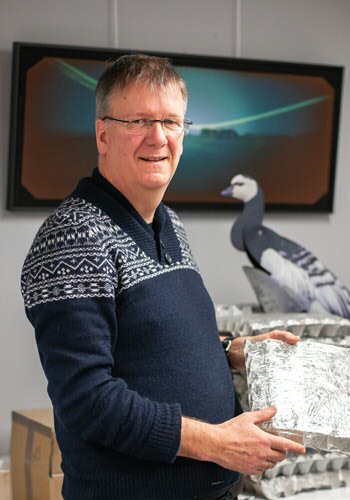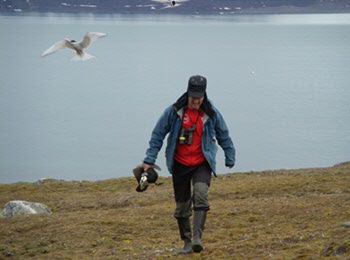Het klimaatverdriet van Maarten Loonen

De klimaatverandering op Spitsbergen: Maarten Loonen maakt het al jaren aan den lijve mee. Hij kan uren vertellen over ganzen, rendieren en gletsjers, over de onmetelijke en ons onbekende natuur. Maar het meest raakt hem de klimaatklok die voorttikt.
Tekst: Eelco Salverda, afd. Communicatie RUG
Als een privémuseum, zo oogt zijn kamer. Twee laarzen met een sticker: ‘vervoer, M. Loonen’. Drie Noordse sterns van papier maché aan het plafond, opgestapelde eierdozen met theezakjes erin, een zelfgemaakte pinguïn op twee grote vriezers. Twee vriezers? Loonen trekt ze even open: drie dode ganzen verpakt in plastic, bloedmonsters voor onderzoek naar het immuunsysteem. ‘Ja, alles wat we ooit verzameld hebben bewaar ik hier. Een echte opslag zou inderdaad niet zo gek zijn,’ lacht hij verontschuldigend.

Theezakjes in de wildernis
De theezakjes zijn onderdeel van een wereldwijd onderzoek naar afbraak van plantaardig materiaal. Ze hebben een jaar in de grond gezeten op Spitsbergen. Maarten Loonen komt daar al dertig jaar, in het onderzoekersdorp Ny Ålesund, voor onderzoek naar onder meer ganzen. Hij weet nog goed wat hem het meeste trof bij het eerste bezoek. ‘De superindrukwekkende wildernis. Het fjord bij het dorp, waar zes gletsjers op uitkomen. De natuur die wij niet kennen. Wist je dat een ijsbeer met de tijger het enige dier is dat de mens als prooi ziet? Ze kunnen heel stilletjes dichterbij komen, zonder dat je het merkt. Of het lijkt dat ze ergens anders aandacht voor hebben. En dan ineens, als ze je genoeg genaderd zijn, rennen ze op je af. Dan ben je kansloos.’ Als ecoloog probeert hij te ontrafelen wat we om ons heen zien. Dat is een uitdaging op Spitsbergen. ‘Die plek, dat snap je niet. Er zit een figuurlijke gelaagdheid in de natuur die je niet kent, en je ontdekt steeds meer.’ Loonen zou de afgelopen jaren veel ontdekken, tot zijn verdriet.
Het nieuwe normaal
Een gesprek met Loonen gaat al snel over klimaatverandering en de gevolgen daarvan. ‘Alle gletsjers zijn zo’n drie kilometer gekrompen. Ik zie bergen en vaar langs eilanden die altijd onder het ijs zaten. Vroeger hoorde je het in het dorp donderen als er een stuk gletsjer afbrak en in zee viel. Nu is het stil.’ Tijdens het gesprek buigt hij meermaals naar zijn computer om statistieken en grafieken te tonen. Temperatuur, ijshoeveelheden, een kaart met Spitsbergen als donkerrode vlek in het Arctisch gebied. ‘Hier zie je dat de temperatuur op Spitsberen veel sneller stijgt dan elders. Zulke grafieken laten me niet los, ik kijk er de hele dag naar. Het ergst van alles vind ik dat we ons al bijna niet meer realiseren dat het vroeger anders was. Klimaatstatistieken tonen vaak het gemiddelde van de afgelopen 30 jaar. Maar daar zit al een stuk opwarming in verdisconteerd. Je referentiekader verschuift op die manier.’

Open fjord
Aanvankelijk maakte Loonen zich niet zo druk om klimaatverandering. ‘In 1990 zei een glacioloog me nog dat het bij Spitsbergen wel mee zou vallen. Ik denk dat sommige politici er eerder bij waren dan ik,’ grapt hij. Zijn visie veranderde in 2006. ‘Voor het eerst in het bestaan van Ny Ålesund, sinds 1917, vroor het fjord niet meer dicht.’ Een incident werd permanent: het fjord is nooit meer dicht geweest. En Loonen zag meer veranderen. Ganzen kwamen eerder broeden, ijsberen doken op in het dorp op zoek naar voedsel, de gletsjers kalfden af, ringelrobben verdwenen en zeehonden verschenen. Het aantal weken dat de temperatuur gemiddeld boven 0 ligt nam met een derde toe. ‘Er waren altijd wel kleine veranderingen. Maar tien jaar geleden ging het ineens met een grote schok. Zelfs in de winter is het nu wel eens boven 0. Gevolgd door zware regenval, die dan weer bevriest. Dat heeft grote gevolgen voor de toendra en het leven daar. Rendieren kunnen door bevroren regen niet bij hun voedsel. Op Spitsbergen zijn woningen onbewoonbaar door aardverschuivingen en moet nieuwbouw gestut worden. Stel je eens voor, dat je huis niet meer veilig is. Dat is na oorlog en ziekte het ergste dat je kunt meemaken.’
Sluipmoordenaar
Als onderzoeker heeft hij altijd gewerkt met modellen en voorspellingen. Het gaat niet meer, zegt hij. ‘Je weet niet meer waar het heen gaat. Global warming betekent niet dat we hier een lekkere Franse zomer krijgen. Het betekent onvoorspelbaarheid.’ Is er niet iets van een wetenschappelijke nieuwsgierigheid waarmee hij naar de ontwikkelingen kan kijken? ‘Nee, niet meer,’ zegt hij resoluut. ‘Het is angst. De gedachte dat wat ik daar zie hier ook kan gebeuren. Dat alles eerst heel langzaam gaat en dan onomkeerbaar snel.’ Het beeld van de ijsbeer doemt op, die je in slaap sust, afwacht en toeslaat. Het klimaat als sluipmoordenaar.
Paniek
Loonens hoofd is rood aangelopen, tranen staan in zijn ooghoeken. Ook later in het gesprek gebeurt dit, als hij spreekt over de schade aan het Great Barrier Reef en de woorden van Ban Ki Moon, eredoctor van de RUG: ‘We are the last generation that can end climate change’. Bijna verbitterd: ‘Vroeger spraken we over de gevolgen voor onze kleinkinderen. Maar wíj gaan het meemaken. Er wordt al vijftien jaar gewaarschuwd. En we zijn geen steek verder gekomen.’ Maar die tranen, dat gebeurt iets te vaak, verontschuldigt hij zich. Waar komt die gevoeligheid vandaan? Krijgt hij wel eens het verwijt de emotionele kaart te spelen? ‘Nee, dat niet. Het maakt indruk en het werkt, gelukkig. Maar ik wil er wel vanaf. Ik overtuig liever met feiten dan met emotie. Ik had me ook voorgenomen het in dit gesprek droog te houden. Het is gewoon de paniek die ik ervaar als ik hierover praat.’ Loonen is van modellenman een ervaringsman geworden. Hij wil getuigen. In zijn eigen woorden: ‘Ik ben boer en leraar. Boer omdat ik van dieren houd en een brede interesse in de natuur om me heen heb, leraar omdat ik een boodschap wil overbrengen.’
Werken op Ny Ålesund
Onderzoek doen op Spitsbergen heeft veel voeten in aarde. Het gehaaide jachtgedrag van de ijsbeer is een van de redenen waarom Loonen en collega’s met een goede uitrusting het dorp uit gaan, op veldwerk. Een schietcursus gevolgd, gebriefd met veiligheidsinstructies, altijd samen. Geweer, verrekijker en radio mee. ‘Ny Ålesund is een onderzoekersdorp, dat eigendom is van een bedrijf. In de zomer zijn er honderddertig mensen, in de winter dertig. Je huurt een verblijfsruimte, het bedrijf zorgt voor eten, afvalverwerking, logistiek en infrastructuur.‘ Onderzoekers van de RUG bemannen er al decennia twee hutten. Betaald door Buitenlandse Zaken, want de aanwezigheid van de onderzoekers is ook van geopolitiek belang. Lachend: ‘Ze hebben me wel eens de goedkoopste ambassadeur van Nederland genoemd.’

Dertig jaar heen en weer
Dertig jaar weg van half juni tot half augustus, wat doet dat? ‘De eerste vijf jaren waren fantastisch. Daarna realiseer je je dat je ook dingen mist thuis. De zomer in Nederland, familie. Langer dan twee maanden zou ik niet weg kunnen. En door mijn jarenlange aanwezigheid mis ik ook een zekere verwondering. Een tijdje terug riepen studenten dat ze een walvis zagen. Ik zei ‘ga maar snel kijken’, maar bleef zelf binnen. Bleek ik een zeldzame Groenlandse walvis te hebben gemist!’
Zomer brengen
Heeft Loonen er wel eens aan gedacht in de winter te gaan? ‘Nee, ik ben een buitenmens, een veldbioloog. De natuur staat stil in de winter, ik wil haar in volle glorie zien! Mijn identiteit is verweven met mijn werk daar. Ik kijk er altijd naar uit om er naar toe te gaan. En ik hoor er thuis, inmiddels. Als ik kom weten de vaste bewoners dat de zomer is aangebroken.’ Loonen, de zwaluw die de zomer brengt. Maar echt goed nieuws voor Spitsbergen zal waarschijnlijk nog lang op zich laten wachten...
- Meer over Maarten Loonen
- Op 14 februari zendt Arte om 17:35 uur een documentaire uit in de serie Habiter le monde, over leven en werken in Ny-Ålesund, met daarin ruim aandacht voor Loonen, zijn studenten en zijn onderzoek.
Meer nieuws
-
19 december 2025
Mariano Méndez ontvangt Argentijnse RAÍCES-prijs
-
18 december 2025
Waarom innoveren, en voor wie?
-
17 december 2025
Ben Feringa wint Feynmanprijs
